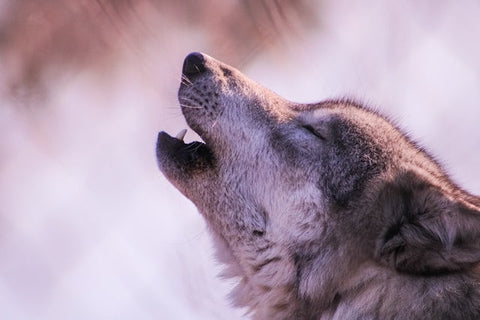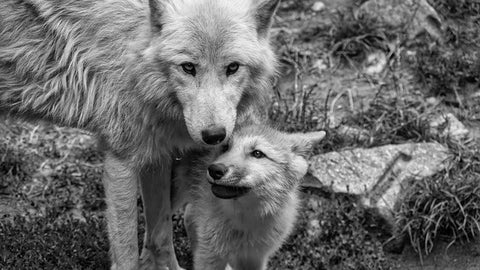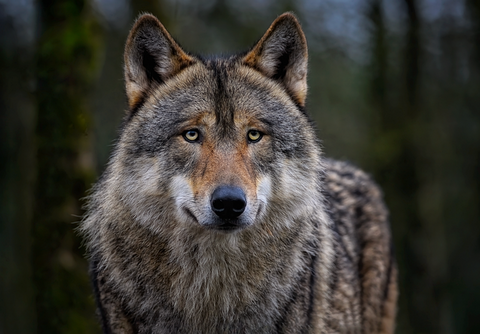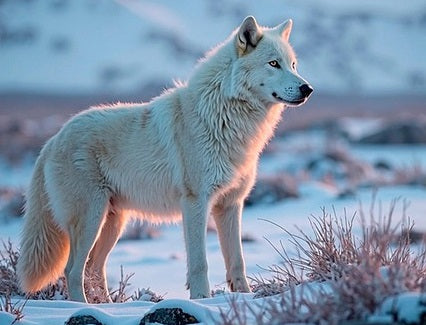
10 Fascinating Facts About Wolves You Probably Didn't Know
of reading - words
Welcome to this article dedicated to wolves, those iconic creatures that inspire both fascination and fear. From the icy tundra to vast forests and majestic mountains, wolves have thrived in diverse habitats around the world. In this wild world, they have adapted to become strategic hunters and social beings with complex communication skills.
In this exciting journey through their world, we'll explore 10 fascinating facts about wolves you probably didn't know. Prepare to be amazed by the diversity of these extraordinary predators and discover their essential role in the ecosystem.
1) The incredible diversity of wolf species across the world
Wolves, belonging to the Canidae family, come in a variety of species, each adapted to its unique environment. Some of the best-known species include the gray wolf (Canis lupus) , the Arctic wolf ( Canis lupus arctos ), the red wolf ( Canis rufus ), and the western wolf ( Canis lupus occidentalis ).
Each wolf species has adaptations specific to its habitat, ranging from the thick white fur of arctic wolves that allows them to withstand icy conditions, to the agile paws and red coats of red wolves that are well-suited to desert regions.
2) The wolf, a master of communication: deciphering the languages of the wolf
Communication plays a vital role in wolves' social lives. They use a complex set of signals, howls, and body language to convey important information within the pack. Howling is one of their most iconic forms of communication, serving to demarcate their territory, call other pack members, and strengthen social bonds.
Body language is also crucial for wolves' communication. Tail movements, body postures, and facial expressions reveal a lot about their emotional state and intentions. They use these signals to maintain harmony and cohesion within the pack.
The main elements of wolf language:
- Howls: to communicate over long distances.
- Body language: to express emotions and intentions.
- Territorial markings: to demarcate their territory and communicate with other packs.
To complete your knowledge on this subject, read this article: Why do wolves howl?
3) Wolves in society: pack life and social organization
Wolves are highly social animals that live in well-structured packs. Each pack consists of a core family of parents and their offspring, but it may also include unrelated wolves who join the pack to strengthen social bonds and improve their chances of survival.
The social structure of the pack is hierarchical, with an alpha pair at the head of the hierarchy. They are generally the only ones to reproduce and play a vital role in making decisions for the well-being of the pack. Other members of the pack have specific roles, such as hunting, guarding the young, and defending the territory.
The typical hierarchy of a wolf pack:
- Alpha couple: at the head of the pack, makes important decisions.
- Subordinate: Subordinate members that assist in decision making.
- Cub Scouts: the young members of the pack, who are protected and educated by adults.
For more information on this, read this article: The Wolf Pack Organization
4) The wolf, a strategic hunter: amazing hunting tactics
Wolves are incredibly efficient predators, using elaborate hunting tactics to capture their prey. Unlike some other predators, wolves are endurance hunters, capable of pursuing their prey over long distances until it becomes exhausted.
When hunting in packs, wolves implement coordinated strategies, communicating using sound signals and body language to surround their prey. Once the prey is located, the wolves work as a team to corner it, then use their combined strength to overwhelm it.
Wolf Hunting Tactics:
- Pack hunting: cooperation to surround the prey.
- Endurance hunting: pursuit over long distances.
- Silent hunting: stealthy approach to surprise the prey.
5) The wolf and its habitat: adaptation and survival in varied environments
Wolves are experts at adapting to different habitats, which has allowed them to colonize various regions of the globe. They can be found in a variety of environments, from the frozen expanses of the Arctic to vast boreal forests and arid deserts.
Their thick fur protects them from the bitter cold, while their powerful paws and sharp claws allow them to move efficiently across varied terrain. Wolves are also able to regulate their metabolism to cope with food shortages, making them formidable survivors even in harsh conditions.
Adaptations of wolves to different habitats:
- Thick fur: protection against the cold.
- Powerful legs: efficient movement in various terrains.
- Metabolism regulation capacity: resistance to food shortages.
6) Wolf vs. Dog: Surprising Similarities and Striking Differences
Wolves and dogs share a common ancestor and have striking genetic similarities. Indeed, domestic dogs are descended from gray wolves, which were domesticated by humans thousands of years ago. However, despite these similarities, they have marked differences, both physically and behaviorally.
Dogs were shaped by artificial selection to meet human needs, while wolves evolved naturally to survive in their wild environment. Wolves retain their hunting instincts and have a more ferocious nature, while domestic dogs have developed a closeness and dependence on humans.
Similarities and differences between wolves and dogs:
- Common origin: shared ancestors.
- Hunting behavior: instinct preserved in wolves.
- Relationship with humans: Dependence developed in dogs.
7) Myths and legends about wolves: separating reality from fiction
For centuries, wolves have been surrounded by myths and legends. They have been portrayed in cultures around the world as mysterious and fearsome creatures, often associated with magic and the supernatural. However, many myths about wolves are based on misunderstandings and false beliefs.
Wolves are not vicious, bloodthirsty beasts, but rather predators necessary for the balance of the ecosystem. They play a crucial role in controlling herbivore populations, thus helping to maintain ecosystem balance and preserve biodiversity.
Common myths about wolves:
- Wolves are man-killers: a misconception stemming from sensational stories.
- Wolves are evil: baseless superstitions.
- Wolves are harmful: a negative perception based on old beliefs.
8) Wolves and Man: Past and Present Coexistence
For millennia, wolves have shared territories with humans. Their coexistence has been complex, ranging from fear and hostility to a greater understanding of the importance of preserving these predators for ecological balance.
Unfortunately, coexistence between wolves and humans is not always harmonious. Wolves have been hunted, trapped, and persecuted in the past, but today, conservation efforts aim to protect these iconic animals and find solutions to avoid conflicts with local populations.
Past and present coexistence between wolves and humans:
- Historical hunts and persecutions: a strained relationship in the past.
- Awareness of the need to preserve wolves: efforts for conservation.
- Conflict Management: Finding Solutions for Peaceful Coexistence.
9) Wolf conservation: issues and initiatives to protect this iconic species
Wolf conservation is essential to preserving biodiversity and ecosystem health. Unfortunately, wolves continue to face threats such as habitat loss, poaching, and conflict with humans.
Conservation initiatives have been implemented to protect wolves and restore their populations in some areas. Reintroduction programs, education campaigns, and awareness-raising efforts are underway to promote coexistence between wolves and human communities.
Issues and initiatives for wolf conservation:
- Habitat loss: protecting natural wolf habitats.
- Poaching: Enforcement of strict anti-poaching laws.
- Reintroduction: programs to restore wolf populations in certain locations.
- Education and awareness: campaigns to promote peaceful coexistence with wolves.
10) The wolf is a symbol of power and wisdom in many cultures
The wolf is a powerful and wise symbol in many cultures, associated with qualities such as:
- Strength: Renowned for its physical and mental power, the wolf is admired for its courage and determination.
- Loyalty: The wolf is a social animal that values pack cohesion and the protection of its members.
- Perseverance: Endowed with unwavering tenacity, the wolf shows determination in hunting and survival.
- Wisdom: The wolf is considered a watchful guardian and messenger between the earthly and spirit worlds.
Revered as a totem or spirit animal, the wolf embodies the connection between man and nature, evoking respect and admiration. However, as societies evolved, its image was also tarnished, but the wolf continues to fascinate and inspire through time.
Wolves are undoubtedly fascinating creatures that deserve our admiration and respect. Their essential role in the ecosystem as predators that balance herbivore populations is crucial for maintaining biodiversity and harmony in nature.
By separating the reality from the myths surrounding wolves, we can better understand them and contribute to their conservation. It is time to recognize their importance and work together to ensure peaceful coexistence between wolves and humans.
Do you enjoy the world of wolves ? Discover a wide range of products at the Terre des Loups store : wolf tattoos , wolf t-shirts , wolf jewelry , wolf pendants , and more...







